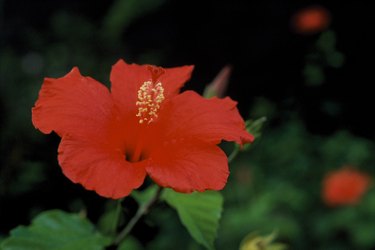Things You'll Need
Paper envelopes
Sharp knife
Garden spade
Sterile potting medium and pots

Mallows are herbaceous or woody annuals, biennials and perennials that grow from the tropics to temperate areas. Many are grown as garden flowers. Some, like hollyhocks and rose mallow are familiar old-fashioned garden plants and some, like swamp and salt marsh mallows, specialize in certain types of environments. Some like the Chinese hibiscus are tender perennials and grown as annuals. Dozens of varieties can be easily propagated by seed. Many can also be propagated using new wood cuttings or division.
Propagation by Seed
Step 1
Harvest seeds from the purse-shaped pods that form on all mallows. Wait until pods are dry and ready to burst open. Collect the little black seeds in paper envelopes.
Video of the Day
Step 2
Sow seeds from musk mallow, hollyhocks and many other mallows immediately in well-drained soil in full sun.
Step 3
Cover the small seeds lightly, 1/4- to a 1/2-inch deep, and water well. Plant biennial hollyhocks as early in the season as they are harvested so they can get a season of vegetative growth in and bloom the next summer.
Step 4
Store seeds in a cool dry area if planting is to be delayed until spring; cold inhibits germination.
Step 5
Plant seeds in the garden after the last frost when soil temperature reaches 70 degrees Fahrenheit. Plant in well-drained soil in full sun and cover lightly.
Propagation by Cutting
Step 1
Take green wood cuttings from hibiscus and other woody mallows in spring as growth begins.
Step 2
Cut 4- to 6-inch starts from the ends of young plants in the morning. Keep cutting ends moist.
Step 3
Plant at least the bottom inch of each cutting in sterile, soil-less potting mixture.
Step 4
Put the potted cuttings in a place where they will receive bright indirect light and the air temperature is between 60 and 80 degrees. Keep the cuttings evenly moist.
Step 5
Move the cuttings to the garden after the weather has settled. Successfully rooted cuttings will resist when grasped at the base of the cutting and pulled lightly.
Video of the Day
Propagation by Division
Step 1
Divide shrubby or clumping mallows like musk mallow in spring.
Step 2
Dig mallow clump up and divide it with a sharp knife or shovel.
Step 3
Allow the exposed cut surfaces to dry before re-planting.
Step 4
Re-plant divisions at the same height as the parent clump.
Tip
Mallows propagate easily by seed; most self-sow prolifically, providing seedlings to dig up and move to new places. Reserve vegetative reproduction for fast starts and division for older plants when bloom begins to decline.
Mallows like slightly alkaline soil. Check for a pH between 6.8 and 7.2 before planting mallows in a new location.
Water all mallows well when planting. Although some mallows are drought resistant, they all need evenly moist soil until they establish themselves and start growing actively.
Warning
Check on a specific variety’s requirements before planting; hibiscus and hollyhock crave full sun but some like the Gulf Coast native red mallow require part to full shade.